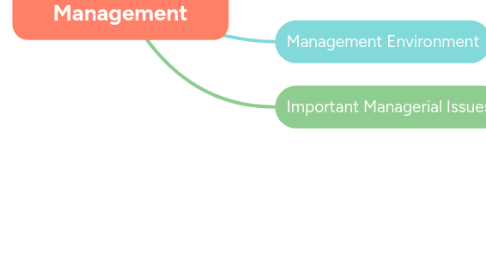
1. Managers and Management
1.1. Definition
1.1.1. Organization: An organization is a deliberate collection of people brought together to accomplish some specific purpose.
1.1.2. Management: a set of activities directed at an organization’s resources, with the aim of achieving organizational goals in an efficient and effective manner.
1.1.3. Manager: someone whose primary responsibility is to carry out the management process.
1.2. Kinds of Managers
1.2.1. Levels of Management
1.2.1.1. Top Managers (president, vice president, chancellor, managing director, COO, CEO,...)
1.2.1.2. Middle Managers (department head, project leader, unit chief, district manager, division manager, store manager,...)
1.2.1.3. First-line Managers (supervisors, shift managers, office managers, department managers,...)
1.2.1.4. Team Leaders
1.2.2. Areas of Management
1.2.2.1. Functions Managers
1.2.2.2. Administrative Managers
1.3. Basic Management Functions
1.3.1. Planning
1.3.2. Organizing
1.3.3. Leading
1.3.4. Controlling
1.4. Management Skills
1.4.1. Conceptual skill
1.4.2. Interpersonal skill
1.4.3. Technical skill
1.4.4. Political skill
2. A Brief History of Management’s Roots
2.1. Classical Approaches
2.1.1. 1911: Frederick W. Taylor’s Principles of Scientific Management
2.1.2. 1916-1947: Fayol’s general administrative theory and Weber’s bureaucracy theory
2.2. Behavioral Approach
2.2.1. The Behavioral Theory of Management, often referred to as Neo-Classical Management Theory, focuses upon individual behavior, motivations, and social interactions. Specifically, it incorporates the study of human behavior through psychology, sociology, and anthropology
2.2.1.1. Behavioral Approach follows Maslow's hierarchy of needs
2.2.1.1.1. Physiological needs
2.2.1.1.2. Safety needs
2.2.1.1.3. Social needs
2.2.1.1.4. Esteem needs
2.2.1.1.5. Self-actualization needs
2.3. Quantitative Approach
2.3.1. The qualitative approach to management uses the views of experts to create business performance forecasts (William Edwards Deming)
2.4. Contemporary Approaches
2.4.1. Organization as an open system
2.4.1.1. INPUTS: Raw materials, Human Resources, Capital, Technolagy, Information.
2.4.1.2. TRANSFORMATION PROCESS: Employees' Work activities, Management Activities, Technology & Operation methods.
2.4.1.3. OUTPUTS: Products & Services, Financial Results, Information, Human Results.
3. Management Environment
3.1. External environment
3.1.1. Components
3.1.1.1. The political/legal component: federal, state, and local laws, as well as laws of other countries and global laws
3.1.1.2. The demographic component: trends in population characteristics such as age, race, gender, education level,geographic location, and family composition.
3.1.1.3. The economic component: interest rates, inflation, employment/unemployment rates, disposable income levels, stock market fluctuations, and business cycle stages.
3.1.1.4. The sociocultural component: societal and cultural factors such as values, attitudes, trends, traditions, lifestyles, beliefs, tastes, and patterns of behavior.
3.1.1.5. The technological component: scientific or industrial innovations.
3.1.1.6. The global component: issues (like a volcano eruption, political instability, terrorist attack, etc.) associated with globalization and a world economy
3.1.2. External environment factors affect managers
3.1.2.1. Jobs and employment
3.1.2.2. Environmental uncertainty
3.1.2.3. Stakeholder relationships
3.2. Internal environment
3.2.1. Organization culture
3.2.1.1. Components
3.2.1.1.1. Attention to detail: degree to which employees are expected to exhibit precision, analysis, and attention to detail
3.2.1.1.2. Outcome orientation: degree to which managers focus on results or outcomes rather than on how these outcome are achieved
3.2.1.1.3. People orientation: degree to which management decisions take into account the effects on people in the organization
3.2.1.1.4. Team orientation: degree to which work is organized around teams rather than individuals
3.2.1.1.5. Aggressiveness: degree to which employees are aggressive and competitive rather than cooperative
3.2.1.1.6. Stability: degree to which organizational decisions and actions emphasize maintaining the status quo
3.2.1.1.7. Innovation and risk taking: degree to which employees are encouraged to be innovative and to take risks
3.2.1.2. Managerial Decisions Affected by Culture
3.2.1.2.1. Planning
3.2.1.2.2. Organizing
3.2.1.2.3. Leading
3.2.1.2.4. Controlling
4. Important Managerial Issues
4.1. How do organizations go global?
4.1.1. Foreign subsidiary
4.1.2. Strategic alliance - joint venture
4.1.3. Franchising
4.1.4. Licensing
4.1.5. Exporting and importing
4.1.6. Global sourcing
4.2. Definition Globalization
4.2.1. (Cambridge dictionary) Globalization is the increase of trade around the world, especially by large companies producing and trading goods in many different countries
